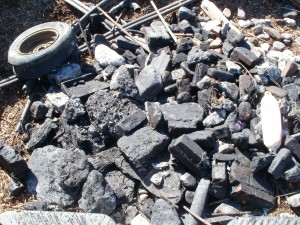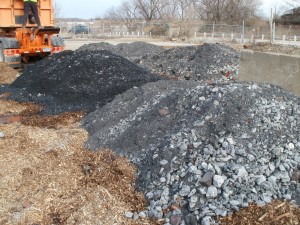November 2012, Vol. 67, No. 11
Features
Large Pipe-Cleaning System Tackles Nashville Challenge

Keeping sanitary sewer lines clear by regular cleaning is an important element in ongoing sewer system maintenance.
A variety of proven cleaning methods are available for pipes in diameters to 36 inches, but none are generally effective for very-large collectors. Pipe 36-inches and larger requires a totally different process for cleaning, said Joe Schotthoefer, vice president of operations, Doetsch Environmental Services, Warren, MI.
Conventional cleaning equipment is very effective for smaller sewer lines, he continues. But as the pipe graduates to larger diameter sizes, cleaning objectives can be insurmountable using traditional cleaning methods because of increased pipe flow, increased debris levels, increased pipe lengths and increased manhole depths.

“There is more water and subsequent flow in large diameter pipes,” said Schotthoefer. “Debris quantities are much greater in large-diameter pipes, and suspended materials do not magically stop at the extraction point — effective and efficient methods must remove them on a continuing basis. The types of debris found in larger pipes also are larger, and can vary from standard grit to small to large rocks, concrete pieces, bricks, construction debris, car parts, bicycles, rags, logs and hardened debris that is adhered to the pipe.”
Special cleaning technology
Doetsch Environmental Services has developed technology and specialized equipment specifically to effectively clean large-diameter sewer pipes. The entire process can be utilized in live sewer conditions, without the need for bypass pumping.
During the Doetsch process, wastewater and debris are vacuumed, separated and transported to a disposal facility. The water is filtered several times and then used as jetting water.
The equipment consists of two major components: a Grand Volumetric Recycler and the Hyjector.

“The Grand Volumetric Recycler extracts debris and water, separates the debris and acts as primary filtration for the water,” explained Schotthoefer. “Water is then pumped to the Hyjector where it is final-filtered, pressurized and sent through the hose reel to the cleaning head. The cleaning head is then propelled through the pipe to a pre-determined point and retracted.”
The method can clean pipe in lengths to 6,000 feet.
Nashville project
A project to clean approximately 9,000 feet of 72-inch diameter pipe in Nashville, TN, provides a good example of the Doetsch method’s capabilities.
Project owner was the city of Nashville. For the large-pipe segment cleaning, Doetsch was a subcontractor for prime contractor Compliance Enviro Systems (CES), Baton Rouge, LA. CES cleaned the smaller pipes and brought in Doetsch for the larger lines. Throughout the project, the debris was not consistent, ranging from grit to heavy debris. Large adhered deposits also had to be removed with high-pressure water. Emergency cleaning was necessary after flooding caused much of the sewer system to be filled with sediment and debris.
Doetsch’s segments of pipe were 72-inch reinforced concrete pipe that was in good condition.
“When we were contacted by CES, there were only three access points, one at each end and one near the middle,” Schotthoefer said. “We prepared to clean from two setups, one at 3,800 feet and one at 5,200 feet. Nashville was very challenging due to the immense length in between access points as well as the depths to 70 feet.”
The middle access point was in the heart of all the downtown activity and is a heavily-traveled destination for tourists and residents.
“After our initial upstream set up, we were able to locate a vertical drop shaft upstream from this access point,” he continued. “The difficulty with this set up was that the 24-inch vertical drop shaft was offset 15 feet from the main tunnel and connected by a smaller tunnel. This made for a challenging and difficult operation for feeding hose and extracting debris.”
After this 2,900-foot run was complete, the process was repeated from the downstream side to the middle access point at historic Fort Nashborough, a shorter run at 1,600. The final run, from the fort to an apartment complex, was the longest at 4,600 feet.
“This access point was in an apartment complex, very close to the dwellings,” Schotthoefer said. “We were able to set up the equipment behind the apartments and operate from the access point remotely. This eliminated heavy truck traffic and noise inside the complex. Our ability to adapt to other staging areas allowed us to move away from the areas that would be disrupted the most. The equipment also was noise attenuated.”
Environmentally friendly
Throughout the cleaning process, there was a continuing communication with the city and the residents.
“An important benefit of the Doetsch large-pipe cleaning method is that it is environmentally responsible,” said Schotthoefer. “The entire operation utilizes recycled sewer water for cleaning operations, reclaiming and continuously recycling sewer water and vacuuming to prevent migration.”
On average, the Hyjector will consume in excess of 200,000 gallons of water per day, says Schotthoefer.
“Using fresh water would place an additional burden on the wastewater treatment plant if they were tasked with treating this increase in wastewater due to the cleaning,” he explains. If the municipality is under drought conditions, cleaning could prove costly because of the potable water consumed for cleaning. Recycling water not only prevents wasting fresh water and reduces residential inconvenience, it also enables us to clean an entire waste stream with no need to bypass pump, plug or shut the system down. Without using neighborhood hydrants, complaints of low pressure and brown drinking water or the potential repairs that will be needed for the water main after usage-related stressing, are eliminated as are costly traffic detours or other inconveniences to the residents, such as lengthy road closures due to excavations for repairs.”
Schotthoefer said the equipment is designed and manufactured by Doetsch and is in a constant state of innovation.
“We have not yet encountered a project that did not require equipment modifications as well as special fabrications to overcome new challenges,” he added. “As we are exposed to more difficult projects, our labor and equipment continues to reach new levels of service excellence.”
Cleaning of the 9,000-foot section was completed in six months.
“More than 1,500 tons of debris was removed from these segments. CES performed the long reach final inspection using a combination of sonar and CCTV. The survey revealed that there was less than three tenths of one percent debris remaining impacting flow capacity,” Schotthoefer said.
The project was the first time the city of Nashville had used the Doetsch cleaning method.
“We had our doubts on whether or not the pipe could be cleaned given the long distances and depths of the line,” said Joe Atol of CES. “Doetsch convinced me they could clean the pipe after numerous site visits and conversations. We submitted our plan to Nashville Metro and, once approved, manufacturing of the equipment began. After all the obstacles, I was very pleased Doetsch was able to clean the pipe ahead of schedule, and CES was able to inspect the long distance.”
Established in 1898, Doetsch Environmental Services, a fifth generation family business, offers professional cleaning services of wet and dry materials, located above or below ground. Clients include municipalities, manufacturing facilities, power plants, foundries, chemical plants and refineries. Sewer line backups and spills of oil and hazardous wastes are handled on a daily basis by Doetsch crews.
FOR MORE INFORMATION:
Doetsch Environmental Services, (586) 755-2090, www.doetschenv.com




Comments